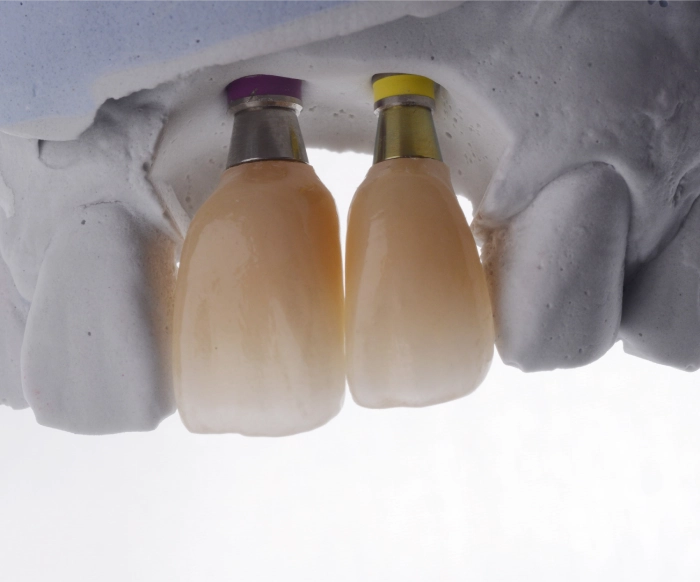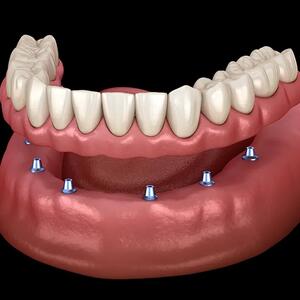Front Tooth Implant
Looking for solutions to restore your front teeth? At Dental Portal, we reveal everything about front tooth implantation: from choosing implants to post-procedure care. Learn how to preserve the beauty of your smile with modern methods. Our article will provide you with the necessary answers and confidence in your treatment choice.
Features of Front Tooth Implantation

Key aspects of implantation in the frontal area:
- Beautiful gum contour. After implant placement, the gum may heal unevenly. To ensure a uniform mucosal contour with adjacent teeth, a temporary crown is fixed immediately after implantation. It helps maintain the shape of the gum and aesthetics.
- Proper selection of the implant and crown. The implant should not be visible under the gum and crown. The color of the prosthesis should match the color of the natural enamel.
- Installation of a temporary crown. The temporary crown not only forms the gum contour but also restores the aesthetics of the smile. Without it, the implant remains unloaded, and the absence of a tooth becomes noticeable in the frontal area of the smile.
Important!
It is ideal if the dentist installs temporary crowns immediately after the implantation of the front teeth and removes them from the bite. This is necessary to maintain aesthetics while the artificial root is integrating.
Indications
- Fracture or significant crack in the tooth root;
- Need to remove a front tooth;
- Absence of an incisor or canine;
- Loss of all front teeth.
Methods of Front Teeth Implantation
- Missing one tooth. The dentist performs the implantation and places a crown on the artificial root. This method does not harm adjacent teeth and prevents bone atrophy.
- Missing three to four teeth. In this case, it is less traumatic to place two implants and attach a bridge prosthesis with three to four crowns. The outer crowns are placed on artificial roots, while the middle crowns are suspended. Artificial roots provide high stability and distribute the chewing load properly.
- Missing all front teeth. Installing a long bridge prosthesis on two implants is unreliable. If 4-6 teeth are missing, the dentist places 3-4 artificial roots and attaches one or two shorter bridge prostheses.
In case of complete tooth loss, the dentist can fully restore the entire dental row in one procedure following the All-on-4/6 protocol. The specialist places 4-6 implants and attaches a complete prosthesis with 12-14 crowns.
Which implantation method is better for front teeth?
Dentists often use:
- One-stage method. The dentist places the artificial root and immediately attaches a temporary prosthesis.
- Immediate method. In the absence of contraindications, the dentist places the titanium post and prosthesis immediately after tooth extraction.
The two-stage method is not suitable for front teeth, as it is not possible to immediately place crowns after implant placement. The integration process of the artificial roots before loading takes 3-6 months, during which time it is impossible to restore the aesthetics of the smile.
Stages of Implantation
-
01Anamnesis and Diagnostics
- The dentist inquires about when the front teeth were lost. He examines the oral cavity to assess the condition of the adjacent teeth and gums. Then, he conducts a computed tomography (CT) to thoroughly examine the jaw's anatomy, bone volume, and the position of the roots of the adjacent teeth. To assess potential contraindications and minimize the risk of complications, the specialist prescribes tests such as a complete blood count and biochemical analysis.
- Based on the collected data, the implantologist plans the restoration process: selecting the method, type of teeth, and material for the prostheses.
-
02Oral Cavity Sanitation
- Before the surgical step, the dentist performs a complete treatment and cleaning of the teeth and gums. This is necessary to prevent the entry of pathogenic bacteria or infections into the surgical area. Otherwise, inflammation may occur after the implantation.
-
03Implant Placement
- Depending on the implantation method, the surgical step may vary:
- Immediate Implantation. The dentist removes the tooth along with the root and immediately places the artificial root in the socket of the removed tooth. Then, he sutures the gum.
- One-Stage Implantation. The implantologist makes an incision in the gum, forms a socket for the artificial root, and screws it in. Then, he sutures the mucosa.
- In one-stage implantation, the artificial root can also be placed through a puncture without cutting the gum. In this case, the dentist uses a surgical template created based on the jaw model, with holes for the implants. This reduces the risk of errors and increases the accuracy of the implantation.
- Depending on the implantation method, the surgical step may vary:
-
04Prosthesis Fixation
- An abutment is placed on the artificial roots, and a temporary crown is fixed on the same day. It is attached using screw threads or dental cement. The temporary prosthesis can only be replaced with permanent ones after 3-6 months, once the artificial root has fully integrated into the bone.
Contraindications
1. Relative Contraindications
Implantation should be postponed in cases of:
- Gum inflammation, exacerbation of an infection;
- Bite disorders;
- Age under 18 years;
- Pregnancy or breastfeeding;
- Bruxism (increased tone of the masticatory muscles, teeth grinding);
- Uncontrolled diabetes mellitus;
- Undergoing radiation or chemotherapy.
2. Absolute Contraindications
Implantation is not possible in cases of:
- Blood coagulation disorders (coagulopathy);
- Bone diseases (osteoporosis);
- Cardiovascular diseases, presence of a pacemaker.
Indications for Bone Grafting
Bone grafting before implant placement in the upper jaw is necessary in cases of significant bone deficiency – when it is impossible to securely anchor the implant in the jaw.
Which Prostheses Are Suitable for Implants in the Smile Zone?
The main requirement for crowns in the frontal smile zone is aesthetics. The prosthesis should visually match the adjacent teeth. Most suitable are:
- E-max Ceramic. A pressed, sturdy material. Crowns made of this ceramic have a natural shade and slight transparency. For their fixation, a zirconium abutment is best suited, which is not visible under the prosthesis.
- Zirconium. A robust and durable material, whose natural appearance is achieved with ceramic veneering.
Metal-ceramic crowns are less suitable. They are less robust and look less natural. The dark metal can show through the ceramic and over time may cause the gum to turn a bluish color due to oxidation.
Post-Implantation Care
In the first week:
- Change your diet. For the first 2-3 hours after implantation (while the anesthesia is effective), it's better to avoid eating. Afterwards, until the completion of osseointegration, prefer soft food and avoid extreme temperatures (hot or very cold).
- Gently clean the oral cavity. Especially around the placed artificial root. Avoid using a toothbrush, use mouth rinses: hold an antiseptic solution in your mouth, then spit it out.
- Apply cold compresses. Apply something cold to the implantation area for 10-15 minutes. In the first 1-2 days every hour, then several times a day. Cold compresses help reduce swelling.
During the osseointegration period (3-6 months):
- Use a soft toothbrush. Avoid toothpastes with abrasives that can damage the gum and the surface of the crown.
- Avoid situations that can increase pressure. Air travel, stress, alcohol consumption, high temperatures, scuba diving, intense physical activity. Increased pressure can lead to bleeding.
- Reduce smoking or decrease the number of cigarettes. Hot cigarette smoke can cause micro burns on the mucosa. This can also trigger bleeding and slow down healing.
Questions and Answers
What is the procedure for front teeth implantation?
The procedure includes tooth extraction, possible bone grafting, implant placement, healing, abutment placement, crown fabrication, and subsequent care.
What are the advantages and disadvantages of dental implants?
Advantages: prevention of bone tissue atrophy, durability, improved appearance, increased self-confidence, ability to eat any food. Disadvantages: cost, need for bone grafting in some cases, theoretical risk of complications (if the doctor's recommendations are not followed).
What factors should be considered when choosing between dental prostheses and implants?
Consider the cost, bone tissue health, time investment, aesthetic preferences, comfort, and maintenance requirements.
What is the cost of front teeth implantation?
The cost varies depending on the number of implants, the type of implant material, and additional procedures such as transplantation. The cost of implanting a single tooth can range from $1,500 to $3,000, while implanting several front teeth can cost from $3,000 to $10,000.
How long does the healing process take after front teeth implantation?
The healing process can vary, but typically takes from 6 to 12 weeks. During this time, osseointegration occurs, where the bone fuses with the implant.


